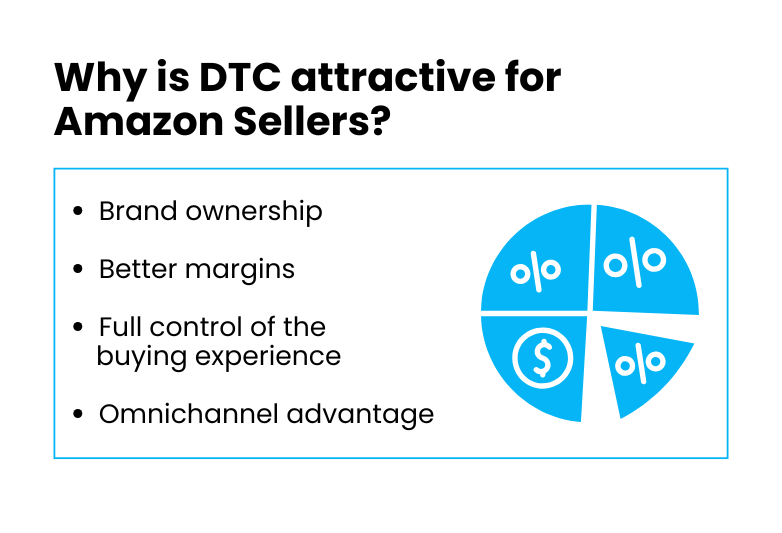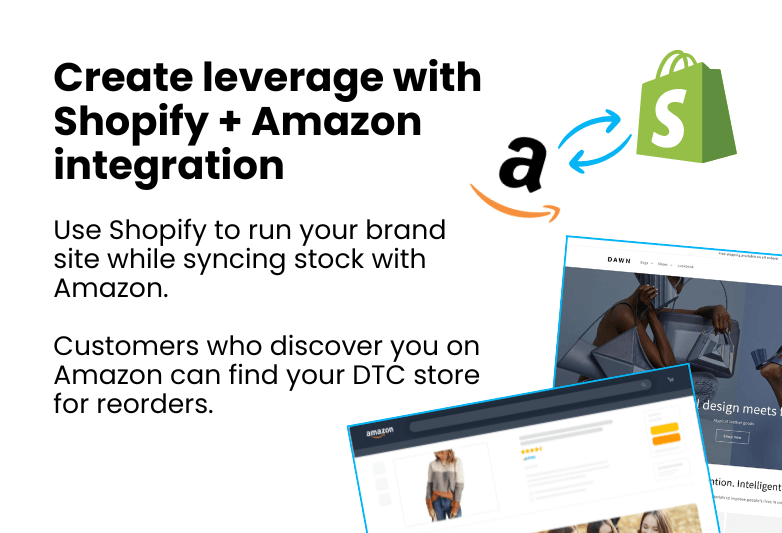intelliRANK Blog
DTC Opportunities for Amazon Brands in 2025
Get the FREE 4-step Strategy Plan eBook
that will help you Increase your Amazon Sales immediately...
Why is 2025 the Time to Expand Beyond Amazon?
Amazon is still the king of ecommerce. For millions of shoppers, it’s the default search bar for buying almost anything.
But when talking to many of the sellers out there, most of them will tell you the same thing. In 2025, running your entire business on Amazon alone is riskier, and more expensive than ever.
We have the advertising costs going up. Amazon fees are eating even more into the margins. Competition is brutal. And worst of all, you don’t actually own your customers. You’re renting space on Amazon’s shelf, and that rent keeps going up.
That’s why so many Amazon brands are looking at direct-to-consumer (DTC) as the next big move.
But nobody is leaving Amazon.
Building your own channel doesn’t mean you should stop selling on Amazon.e
On the contrary, it means creating a second growth engine, one you actually control.
Let’s break down why 2025 is the right year to explore DTC opportunities for Amazon brands, and how to do it smartly.
The Limits of Relying Only on Amazon
If you’ve built a business on Amazon, you know the upside: scale, exposure, and access to millions of shoppers. But you also know the downsides:
No customer ownership. You don’t get emails, first-party data, or any direct way to build loyalty. If a buyer loves your product, Amazon owns that relationship, not you.
High costs. Between FBA, referral fees, and PPC, it feels like you’re paying Amazon three times just to reach your own customers.
Fragile visibility. Algorithm shifts, stock-outs, or a wave of new competitors can push you off page one overnight.
Limited branding. On Amazon, your brand story is confined to bullet points and A+ content.
For many sellers, it feels like walking on eggshells: one policy change or rising ad cost can throw off your entire business model.
Why is DTC Attractive for Amazon Sellers in 2025
So why are more Amazon brands launching their own DTC stores in 2025? A few reasons stand out:
You own your brand. A Shopify store lets you collect emails, build a loyalty program, and create repeat buyers.
Better margins. You’re not stacking commissions, fulfillment costs, and rising PPC bids on top of each other.
Control the experience. From packaging to pricing to upsells, you design the journey instead of fitting into Amazon’s mould.
Omnichannel advantage. Amazon becomes your discovery engine, while DTC becomes your retention engine.
And here’s the big consumer shift: according to a 2025 Shopify survey, 63% of shoppers say they prefer buying directly from brands if given the option. That’s a massive opportunity sitting on the table for Amazon sellers.

Key DTC Opportunities for Amazon Brands
Here’s where Amazon brands can create real leverage with DTC in 2025:
1. Shopify + Amazon Integration
Don’t think of it as either/or. Use Shopify to run your brand site while syncing stock with Amazon. Customers who discover you on Amazon can find your DTC store for reorders.
2. Subscription Models
Amazon Subscribe & Save is limited. On your own site, you can create real subscription programmes with perks, bundles, or loyalty rewards — driving predictable revenue.
3. Personalisation with AI
Amazon recommends products based on what it wants to push. On your site, you control the algorithms. AI tools let you tailor the store experience based on past behaviour, location, or even browsing patterns.
4. Loyalty & Retention Programmes
A simple points system or VIP membership on Shopify can keep customers coming back — something that’s impossible to run effectively on Amazon.
How to Start DTC if You Only Sell on Amazon - Practical Steps
If you’re thinking of testing DTC in 2025, don’t overcomplicate it. Start lean and build momentum:
1. Launch a branded Shopify store. Pick your top products and focus on presentation and storytelling.
2. Don’t move everything at once. Start with your bestsellers, not the full catalogue. Test demand, then expand.
3. Invest in owned channels. Build an email and SMS list from day one. These are assets Amazon can’t touch.
4. Start collecting data for Google and Meta pixels. Those powerful platforms can really drive your growth further, and you should start working on them asap.
5. Leverage Amazon traffic. Add inserts, warranty registrations, or loyalty sign-ups in your packaging to incentivise customers to switch from Amazon to your DTC channel.
6. Keep fulfilment simple. Use FBA to avoid bottlenecks as you scale and simplify your operations in the beginning. You can optimize your costs on logistics at bit later.

A Quick Case Snapshot
One Amazon home goods brand made the shift in 2023. Instead of moving everything, they launched just three of their top products on Shopify. Within the first year:
They built an email list of 50,000+ customers.
Their repeat order rate hit 28%, compared to 0% on Amazon.
Overall margins improved by nearly 20%, because they weren’t double-paying for traffic.
Amazon remained their discovery engine, but their DTC store became the profit centre.
Conclusion: 2025 is the Year of Control for Amazon Sellers
If you’re selling on Amazon, keep selling on Amazon. The platform isn’t going anywhere. But don’t ignore the DTC opportunities for Amazon brands that are opening up in 2025.
DTC isn’t about abandoning the marketplace — it’s about building something alongside it that you own. Your brand, your customer list, your margins.
Amazon can power your growth, but DTC is what will protect your business long-term.
And in 2025, that balance might just be the smartest strategy you can make.
© Copyright 2025 - intelliRANK.info - All rights reserved. Terms of Service. Cookie Declaration.










